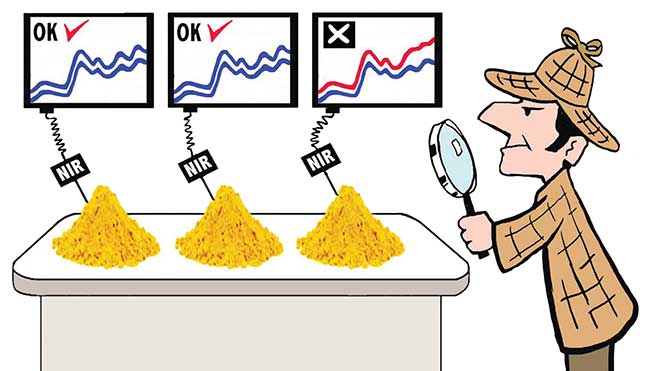Recent research reveals spectroscopy’s potential impact in commercial food production facilities and in the surgical suite.
For decades, spectroscopy has been used in the life sciences, pharmaceuticals, and even cosmetics and forensics applications. Now, researchers are finding new applications for this noninvasive technique in a broad and growing market.
New technique allows pre-hatch chicken gender reveal
Optical spectroscopy is proving that it just might be okay to count your chickens before they hatch. This method is providing hatcheries with a noninvasive, nondestructive way to accurately determine the sex of a chick within four days of an egg being laid.

Optical spectroscopy is providing poultry hatcheries with a noninvasive, nondestructive way to accurately determine the sex of a chick before it hatches.
A team from the Technical University Dresden in Germany and Vilnius University in Lithuania found that optical spectroscopy essentially picks up on differences in the fluids contained in an egg from which a cockerel will develop, compared to one from which a hen will hatch.
Using a laser that emitted at a wavelength of 785 nm, the researchers investigated 27 eggs for up to 11 days after being laid. Within just a few days after incubation, sex-related differences were already evident in the near-IR fluorescence spectrum. According to the researchers, further analysis showed that the blood of male eggs demonstrates a specific fluorescence band located at ~910 nm. The researchers then looked at whether these fluorescence characteristics could be used to classify if a hen or a cockerel will develop, when coupled with changes in the wavelength of light. Tested on nearly 400 eggs, the technique was accurate in 93 percent of cases.
“In ovo sexing based on spectral analysis is noninvasive, does not require extraction of egg material and does not use consumables,” said Roberta Galli of TU Dresden, a lead author on the study that was published in Analytical and Bioanalytical Chemistry (doi: 10.1007/s00216-016-0116-6). “The method is applicable during the fourth day of incubation, before onset of embryo sensitivity at day seven, and is therefore in agreement with animal welfare.”
This optical spectroscopy technique could lead to more ethical practices in the poultry industry. Specifically, it could prevent the annual culling of billions of day-old cockerels worldwide, which have much less economic value than hens, the researchers said, noting that the current global demand for eggs totals about 68.3 million tons per year.
NIR spectroscopy: A developing food science innovation
NIR spectroscopy was first used to monitor food quality in the 1970s when Canada began to replace the very targeted “chemical-requiring and cumbersome Kjeldahl analysis” method to evaluate the protein content in cereals. Kjeldahl specifically measures protein content in food; nitrogen content is also measured with this method and then equated with the protein content.
“We have known and developed [spectroscopy] methods … and they have become better and cheaper over time,” said Soren Balling Engelsen, a professor at the University of Copenhagen’s Department of Food Science (FOOD), and a co-author on a study published in the journal Current Opinion in Food Science (doi: 10.1016/j.cofs.2016.08.001).
NIR spectroscopy is the future of food testing, according to the Copenhagen researchers, but it must be used more broadly in order to be widely effective.
“Even though [NIR spectroscopy] is widely used in the food industry, it can be used far more,” said Klavs Martin Sorensen, a postdoctoral researcher at Copenhagen, and co-author of the study. “It will become more attractive to use [NIR spectroscopy] at production sites, where you previously wouldn’t have been using advanced measuring equipment.”
Nontargeted methods of analysis could better detect food fraud — defined by the U.S. National Center for Food Protection and Defense as “the deliberate and intentional substitution, addition, tampering or misrepresentation of food, food ingredients or food packaging; or false or misleading statements made about a product for economic gain” — than those currently employed.

Near-IR spectroscopy is proving a key tool in detecting food fraud. Courtesy of Sorensen et al./University of Copenhagen.
“The problem is that the food analyses which are predominantly used today are only spot checks and they are typically targeted toward a single kind of food fraud,” Engelsen said. “When you want to detect food fraud and food adulteration, you are not looking for a single substance. [You] have to look broadly.”
The Copenhagen study cited a 2008 case in which the targeted Kjeldahl method unwittingly allowed manufacturers in China to add melamine — an industrial synthetic substance containing 66 percent nitrogen — to milk powder for infant formula. They falsely claimed to consumers that this provided more protein; instead, adding melamine resulted in six deaths and illness in an estimated 300,000 children. This contamination was able to essentially trick the Kjeldahl method, according to the researchers, as it detected more of the protein. Engelsen said NIR spectroscopy, with its broader, nontargeted analysis, cannot be fooled.
With NIR spectroscopy, light is sent into the food and measured when it comes back, taking a nontargeted physicochemical fingerprint of the food. This offers higher, more comprehensive accuracy than Kjeldahl and other techniques. According to the researchers, the fingerprint obtained will often contain “1000+ spectral variables that each relate to the physicochemical composition of the food in their own unique way.”
NIR spectroscopy can also be used to examine large quantities of raw materials, detecting fluctuations in many different ingredients at once. Such monitoring allows inspection of close to 100 percent of the ingredients and raw materials that go into food production, subsequently reducing manufacturing errors and potential low product quality.
Engelsen said increased use of nontargeted NIR spectroscopy “will definitely be able to save us from many forms of food modification that could be of more or less serious kinds — from receiving lower-quality products to becoming seriously ill.”
Light-reflectance spectroscopy evaluates surgical margins
Emerging as a formidable tool in the life sciences, light-reflectance spectroscopy could enable real-time tissue analysis during prostate cancer surgery, as well as more accurate distinction between malignant and benign tissue.
A team from the University of Texas Southwestern Medical Center, in a study of patients with intermediate- to high-risk disease requiring radical prostatectomy, employed a novel light-reflectance spectroscopy probe to evaluate surgical margins on radical prostatectomy tissue specimens and correlate the findings with pathological examination. Light-reflectance spectroscopy analysis was performed on 17 prostate gland specimens, of which a total of 11 histologically positive and 22 negative surgical margins were measured. The optical probe predicted positive surgical margins with 85 percent sensitivity, 86 percent specificity and 86 percent accuracy.
Light-reflectance spectroscopy measures light intensity backscattered from tissues. In prostate cancer patients, a radical prostatectomy — a procedure that entails removal of the prostate gland and some of the surrounding tissue — is often recommended. But due to the amount of time involved with traditional techniques and the lack of proven clinical usefulness, analysis to determine removal of all cancer surrounding the visible tumor’s edges is not routinely performed during surgery.
The benefits of the light-reflectance spectroscopy procedure, once fully qualified, could include highly accurate surgical removal of all cancerous tissue, the researchers said, as well as the ability to spare more healthy tissue, thus minimizing the likelihood of cancer recurrence or need for additional treatment. Further study is required, however, according to UT Southwestern professor Dr. Jeffrey Cadeddu, “to determine whether such analysis may be used in real time to improve surgical decision-making and decrease the amount of tissue surgeons need to remove.”